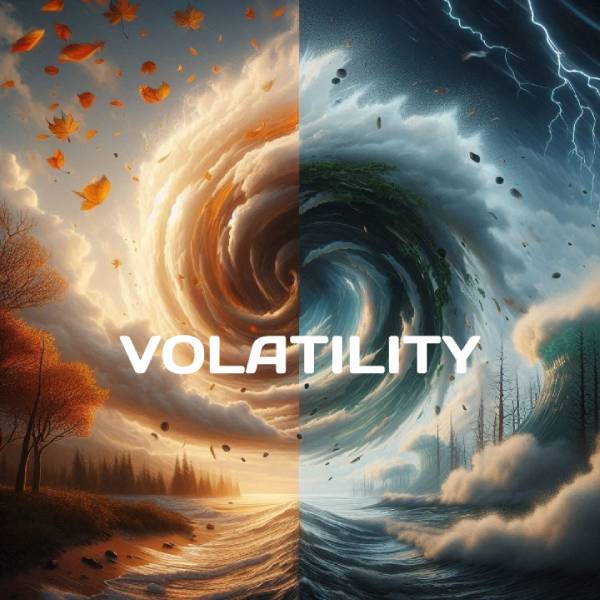
Introduction: A Captivating Look at Fear and Euphoria
Jan 3, 2025
Imagine a rising market where the headlines proclaim endless prosperity, only for an unexpected jolt in trading volumes to signal the start of a swift plunge. That sudden shift often blindsides newcomers and veterans alike, triggering a panic that can erase fortunes in days. Review the last few decades, and you see a repeating pattern: markets surge on confidence, then collapse once collective anxiety gains the upper hand. The housing bubble of 2008 stands as a stark example: demand for ever-inflating property drew in legions, convinced by the belief that prices would continue to climb indefinitely. Then, the entire system swerved into chaos in what seemed like a moment. This emotional cycle—alternating between euphoria and fear—can be monitored through a key instrument known as the market volatility index chart.
Some call it the “fear gauge,” while others see it as a barometer of panic. Whatever label we choose, its spikes warn of surging unpredictability, and its troughs reflect short-lived periods of calm. Yet, beginners often overlook how integral this measure is to successfully navigating the market’s wild rides. Traders glance at daily price swings but ignore the broader sentiment quietly captured by the volatility index. When that index spikes, old lessons from behavioural finance surface: fear is a powerful driving force, just as greed fuels mania on the upswing. Recognising these emotions can aid in timing, whether you’re an investor seeking bargains during panic-driven sell-offs or a careful speculator offloading positions when everything looks too good to be true.
This essay investigates the meaning behind the market volatility index chart, linking it to mass psychology, technical analysis, and the repeated episodes of mania and crashes that define financial history. We will see how contrarian wisdom suggests buying during the chaos and selling in frothy markets. We will also highlight the traps herd thinking can create, enticing investors to dismiss signals that a correction is imminent. At every turn, the volatility index provides a lens through which we can interpret shifts in fear and confidence—insights central to steering clear of destructive impulses and placing ourselves on solid footing before the next upswing or downturn arrives.
The emergence of the Volatility Index: A Window into Crowd Mood
To grasp why the market volatility index chart wields such importance, it helps to see how it reflects crowd emotion on a grand scale. In simpler times, traders kept a close eye on daily price ranges to spot the chances of sudden moves. Over the years, though, financial instruments became more widespread and complex, feeding into bigger booms and busts. Eventually, statisticians and market specialists devised an index capturing the extent of implied price swings in major stock options, a real-time measure of perceived risk. High readings imply a belief that giant moves—either up or down—are more likely, whereas low readings suggest participants expect calmer waters.
Look again at 2008. Before the meltdown, the volatility index chart lingered at relatively modest levels. People were content chasing rising house prices, banking on easy credit, and ignoring hints of credit distress. When the cracks appeared—mortgage defaults climbing, banks reporting losses—fears intensified abruptly. The volatility index soared, mirroring the chaos that erupted as individuals fled once-popular positions and institutions scrambled to cut exposure. In hindsight, that spike was a clear sign that we’d hit a tipping point between complacent greed and urgent fear. Those with the discipline to keep cash on hand could buy shares at steep discounts once the panic reached fever pitch.
It’s no coincidence that the volatility index is sometimes used to time entry and exit points. For instance, contrarian traders note that extreme surges in fear often precede market bottoms. At the same time, extended periods of complacency, with near-zero volatility, can accompany an overheated environment ripe for correction. Yet it’s not all black and white. One cannot simply purchase whenever the index rises and sell whenever it drops. Markets can remain volatile for extended stretches. However, the chart remains an essential tool, reminding participants that risk perception shapes sell-offs—what seems rational in a panicky environment often dissolves if calmer heads prevail. This perspective is vital for understanding why sudden bursts in the volatility index may represent opportunities for the patient and well-prepared.
Mass Psychology and the Lure of the Herd
Trends in the volatility index can be traced back to sentiments found in mass psychology. When markets climb steadily, the majority invests with an air of certainty, further driving momentum. Under these conditions, a quiet readiness to protect one’s gains or lock in partial profits is overshadowed by the crowd’s appetite for more. That collective confidence is seen in subdued volatility numbers: “No one’s worried, so why should I be?” becomes the motto. Then, bad news—maybe slower-than-expected earnings or an unexpected policy shift—toggles the group’s mood almost overnight. Participants scramble to exit, pressing the volatility index upward and unveiling a wave of panic selling.
Historically, mania and herd thinking are recurring phenomena. The dot-com bubble remains a perfect illustration. During the late 1990s, technology shares soared as people fantasised about limitless profits from the internet revolution. Sceptics who doubted companies with minimal revenue were ridiculed as dinosaurs. But cracks emerged when a few high-profile firms missed earnings targets, culminating in a severe downturn that inflicted massive losses on those who stayed too long. Throughout this roller coaster, the volatility index signalled mounting unease. In the final run-up, it remained moderate as exuberance reigned; once reality bit, it catapulted, marking the herd’s shift from complacency to alarm.
Such shifts confirm that traders are not entirely logical. They rely on emotional cues from others, trusting the prevailing narrative: “It’s different this time.” A robust bull market can become self-reinforcing as newly minted profits and upbeat headlines encourage more risk-taking. But once the environment changes, all this confidence can vanish. The volatility index chart decodes that behavioural shift by registering the public’s collective tension. At the darkest moments, it shoots up, handing contrarian participants an opener to act against the trend. This principle underpins the idea that rational investors might capitalise on these shifts, provided they can resist the gravitational pull of herd thinking and rely instead on measured data.
Behavioural Finance: Explaining Panic and Greed
Behavioural finance investigates why otherwise rational people make seemingly irrational decisions with their money. Loss aversion, for example, explains why some traders exit at precisely the worst times, locking in painful losses out of fear that prices may crater further. Similarly, cognitive biases such as overconfidence lead many individuals to hold onto assets in an irrational belief that the merry ride will never end. The market volatility index chart frequently serves as evidence that these biases are at work on a grand scale. When the index remains unusually low, overconfidence is often at a peak; when it spikes, that signals widespread fear, even if the underlying fundamentals haven’t changed drastically.
Dive into the 2008 property bubble with this lens. Leading up to the crisis, banks offered easy loans, and homebuyers jumped eagerly into mortgages beyond their ability to repay. Credit agencies gave top ratings to questionable mortgage-backed securities. From a behavioural finance perspective, people are anchored to the idea that property doesn’t fall in value, ignoring risk factors. Consequently, they overlooked repeated signals that the system was overextended. Only once mortgage defaults started to mount did fear flood the market, with the volatility index reflecting that abrupt about-face. The ensuing meltdown remains a lesson that outside complacency can mask lurking dangers.
Another bias haunting investors is the “recency effect,” where recent events overly shape current decisions. After a stretch of bullish trends, people grow accustomed to small corrections and keep expecting stocks to bounce back with ease. So, any talk of a potential meltdown is brushed aside as doomsday. This extends the calm phase in the volatility index, almost guaranteeing that once negative news breaks through, panic intensifies with full force. That effect stokes the index’s surge as traders scramble to react. Observing these cycles clarifies why the index’s extreme readings can guide more structured decisions—especially if one aims to avoid selling in a panic or buying into a bubble out of fear of missing out. By acknowledging these shared biases, an investor stands a better chance of reading the volatility index chart dispassionately and reacting rationally.
Technical Analysis and the Volatility Index Chart
Beyond raw emotion, technical analysis offers an additional layer of detail for interpreting the volatility index. Where casual observers see spikes and dips, chart-focused traders identify channels, support levels, or divergences. For instance, if the volatility index forms a series of lower highs while the market remains in a modest retreat, that mismatch may suggest fear is abating, and a rally could be brewing. On the flip side, if the index makes higher lows as the market climbs, it may hint that underlying anxiety is growing, foreshadowing turbulence.
Consider the aftermath of the dot-com crash. Even after the initial plunge, negative sentiment lingered as repeated sell-offs tested investors’ nerves. Technical analysts tracked the volatility index for clues about whether fear was truly subsiding. A series of lower peaks on the index chart implied that each sell-off triggered less panic than the last. That signalled that buyers were gradually regaining confidence. Soon enough, an extended rally emerged, confirming that the earlier mania over tech shares had quieted into more measured valuations. Without tracking the volatility index, an onlooker might have missed these subtle shifts in collective emotion.
Some traders overlay the market volatility index on top of standard price charts to confirm signals. They might wait for a moving average crossover in the index or an established trendline break to guess that the market’s mood has reversed. Although this approach can’t be foolproof—no single tool is—used alongside volume data, momentum indicators, and fundamental triggers, it can raise timely flags. Whether you are a short-term speculator employing tactics like “volatility fades” or a longer-term investor hoping to sense when markets are calmer, reading the technical shapes in the volatility index fosters a disciplined mindset. By emphasising data rather than rumour or speculation, you stand a better chance of accurately discerning when fear or greed has been created.
Timing the Extremes: Buying in Fear, Selling in Mania
Many accomplished investors swear by a core principle: harvest profits when times are exuberant and accumulate assets when masses are terrified. The market volatility index goldmine lies precisely in hinting at those extremes. Among the best-known stories is that of individuals who wagered on the market’s rebound in early 2009, a time when the financial system seemed beyond repair, and the index soared. Those contrarians spotted that the panic had possibly hit a zenith, and they capitalised on heavily discounted shares. Within a few years, the recovery rewarded them generously.
This concept parallels the contrarian approach to the dot-com meltdown. Though many tech firms went bust, bigger names or those with real earnings eventually stabilised and climbed again. Anyone relying only on dire headlines from 2002 might have missed out, but watching the volatility index approach massive highs allowed cooler heads to sense that the market had overshot to the downside. The mania had become a mania in reverse: an obsession with negativity. Historically, these moments appear repeatedly, with the index spiking in short, sharp bursts that mirror frenzied capitulation. Those who keep their nerve can do well in such episodes, although it demands the mental fortitude to see panic as a phenomenon to exploit rather than run from.
Yet all that glitters is not guaranteed. The volatility index can remain elevated if crises persist or aftershocks unfold (as in certain stretches of 2008–2009). Traders who rush in prematurely might get “burned” if they fail to confirm a genuine shift in fundamentals or if policy steps are insufficient. The difference between reckless risk-taking and strategic buying rests in thorough research, strong risk controls, and the ability to read multiple signals. The index alone is not a magic bullet—it’s an alarm bell that, when it rings, signals a turning tide in public mood. Combine it with a measured plan—knowing your target exposures, setting stops, or scaling positions—and you can harness fear to your advantage while limiting the hazards of jumping into the unknown.
Reflections and the Path Forward
The market volatility index chart is far more than a novelty—it’s a distilled record of collective moods shaped by greed and fear in roughly equal measure. By scanning its peaks and troughs, we gain an objective viewpoint on how anxious or carefree the market truly is. Reaching extremes often predicts a shift that contrarians aim to exploit. Rarely is the crowd correct at the feverish top or the bleak bottom. The index reveals the times when emotions might be unsustainable, guiding the thoughtful trader or investor toward contrarian decisions.
Still, no indicator replaces a calm mind. Fickle sentiments can trick the best system, and black swan events can jolt even the most well-researched thesis. Spotting a towering spike in the volatility index could signal capitulation, but if underlying fundamentals are deteriorating swiftly, the meltdown may continue. A careful approach merges reading the index with fundamentals such as earnings growth, debt levels, or changes in credit conditions. That synergy helps to confirm whether the panic is overdone or only getting started.
In addition, one must remain watchful of personal biases. Holding onto a stock that soared because it’s comfortable to think it will rise forever is a mistake tied to naive optimism. Selling everything in a meltdown, triggered by blanket fear, is the other extreme. The beauty of tracking the volatility index lies in reminding us to question the mania in a bull market or the despair in a bear market. Maybe the crowd has overlooked rational data. Maybe the group is correct for a time yet fails to see the next turn. By stepping outside the frenzy and using the volatility index as a compass, we stand a better chance of sidestepping mania and meltdown. We can reinforce the old adage: it is seldom wise to follow the crowd’s euphoria or panic. Instead, keep an eye on that chart, note its signals, and cultivate an approach that seizes advantage from extremes instead of being consumed by them.
Conclusion: Adopting a Clear-Eyed View of Volatility
In the final reckoning, the market volatility index chart provides a lens into collective states of mind—one that frequently amplifies the boldest moves for opportunistic traders and investors. Panics like those in 2008, or the mad frenzy of the dot-com bubble, underscore how quickly crowds swing from complacency to despair or from mild optimism to outright mania. Savvy participants learn to harness these swings, realising that what terrifies the majority can present a door to accumulate bargains and that what captivates the crowd may be a point to take profits.
Classical wisdom holds: buy when others are fearful, sell when they are overjoyed. The volatility index is a key sign that fear or euphoria might be peaking. Of course, this gauge should not be used in isolation—risk management, fundamental analysis, and technical signals each have their role. Combined, they form a method to see through the noise and base decisions on both data and emotional undercurrents. By embracing a balanced view of volatility, you can sidestep the pitfalls of herd behaviour, capitalise on opportunities that bubble up when angst is rampant, and maintain composure when the next wave of hype or panic floods the market. That mindset, bolstered by a solid read of the volatility index, lays a foundation for more resilient, consistent success through all phases of the financial cycle.












